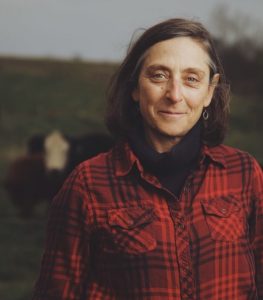
Beth Hoffman was a college professor and agriculture journalist for years before she and her husband picked up and moved from San Francisco to his family’s farm in Iowa. In her book Bet the Farm: The Dollars and Sense of Growing Food in America, she recounts the story of transitioning the farm from commodity corn and soybean cropping to grass-finished cattle and produce––and the challenges they faced along the way, from fencing to finances.
TIMELINE
3’12 making the transition from urban professor to Iowa farmer
5’17 transitioning from row crops to grass finished cattle and produce
8’54 the cost of organic food is high because the cost of growing that food is higher
12’52 you can’t increase yield forever
15’28 the convoluted food system
16’04 the government’s motivation for supplying cheap food
17’44 subidies work for commodity crops but not for grass-finished beef
21’13 farmers get 8¢ on the dollar for food sold
23’42 who’s making the bulk of money in food: the big food companies, not the farmers
27’33 no silver bullets, but some ideas for a better food system
31’58 the two myths: “bigger is better” and the “agrarian tale”
34’45 a lot of pressure on farmers: feed the world, solve climate change, steward the land, basically save humanity
36’52 Prairie Fires book that exposes the false narrative of Little House on the Prairie
39’34 the new storylines to replace those myths
44’02 the practical farmers of Iowa, a farmer-to-farmer group, getting support and sharing information
47’55 even commodity farmers are becoming open to change
49’09 the role of regeneration and its challenges, including labor
51’01 regrowing prairie grasses and native trees on their land
53’34 noting progress over the last five years and hopes for the farm
